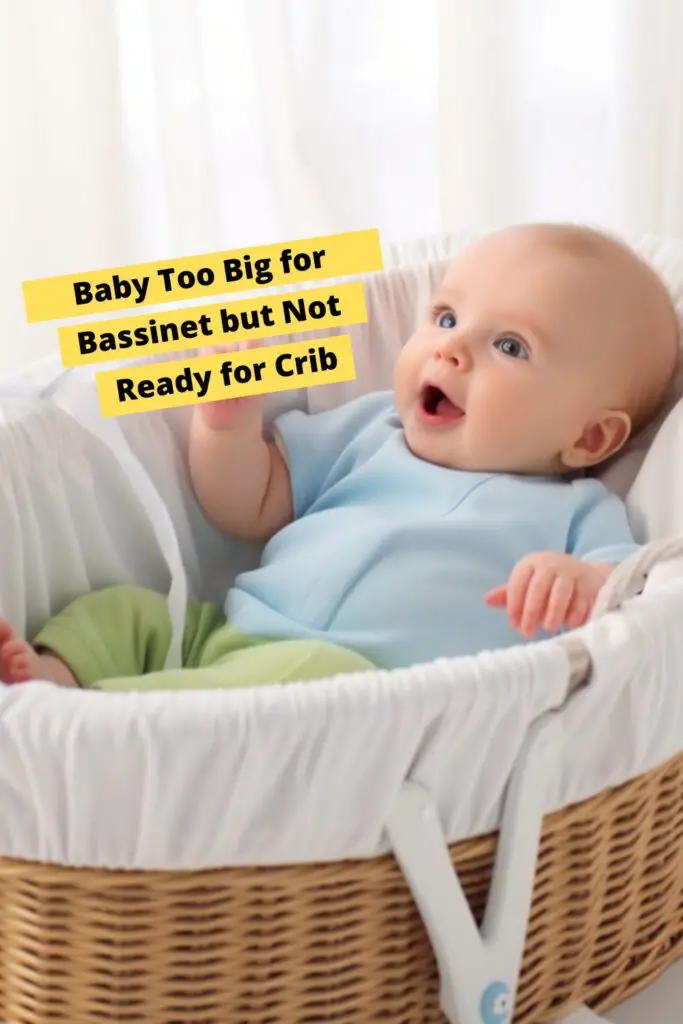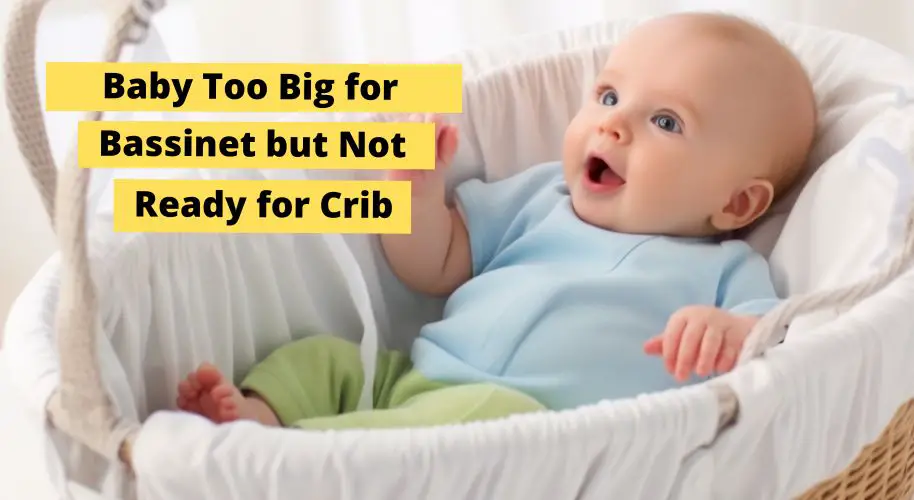Last Updated on June 5, 2025
Welcoming a newborn into your family is an exciting journey filled with countless joys and challenges. One of those challenges is ensuring your baby has a safe and comfortable sleeping environment.
As your little one grows, you might find yourself in a dilemma: your baby has outgrown their bassinet but isn’t quite ready for the big transition to a crib. This situation can be puzzling for parents, leaving them wondering what the next step should be. How do you ensure your baby’s comfort while also prioritizing their safety?
This article aims to guide parents navigating this delicate transitional phase, offering expert advice and practical solutions to ensure your baby’s sleep environment remains as cozy and secure as possible.

Bassinet or Crib: A Quick Contrast
A bassinet is a small, lightweight bed designed specifically for newborns and young infants. It’s portable and compact, making it easy to move around the house. Bassinets are typically used until the baby is around 3-6 months old or starts to roll over or sit up.
A crib, on the other hand, is a larger, more permanent piece of furniture. It’s designed to provide a safe sleep environment from newborn to toddlerhood. Many cribs can convert into toddler beds, providing several years of use. While less portable than bassinets, cribs offer more room for growing babies.
When Your Baby Is Too Big For Bassinet But Not Ready for Crib: What to Do?
Transitioning your baby from a bassinet to a crib can be tricky. It’s common for babies to outgrow their bassinets between 4-6 months of age. Consider alternatives when your baby surpasses the weight limit of the bassinet or starts showing signs of discomfort.
However, if your little one isn’t quite ready for a crib, there are several strategies you can adopt to ensure a smooth transition.
Frequent Day Naps in The Crib
To help your baby get accustomed to the crib, introduce them to the crib during their daytime naps. This gradual introduction can make the crib feel less foreign and more comfortable.
Position The Crib Next To You
Consider moving the crib to your room if space allows. This can help maintain the sense of security and closeness your baby is used to with the bassinet, making the adjustment easier.
Establish a Sleep Cycle
Establish a consistent sleep cycle to help your baby adjust to the new sleeping environment. A predictable routine can provide comfort and aid in smoother transitions.
Create a Safe Space
Ensure the crib is a safe space for your baby. This includes ensuring the crib meets safety standards, is free from loose bedding or toys, and has a firm mattress.
Consider a Bigger Bassinet or Mini Crib
If your baby has outgrown their current bassinet but is still getting ready for a full-size crib, consider transitioning to a larger bassinet or a mini crib. These options provide more space while still offering the snugness of a bassinet.
Familiarize Your Baby with The Crib
Get your baby familiar with the crib even before the transition. This could involve playtime in the crib during the day so that the space becomes familiar and less daunting when it’s time to sleep.
You Might also Like These Resources!
When It’s Time to Move: Baby, Bassinet, and the Crib Connection

The journey of parenthood is a beautiful dance of growth and change, and nothing quite symbolizes this more than your baby’s transition from the bassinet to the crib. This process can be both exciting and anxiety-inducing for parents. When should you make the move? Is your baby ready? How will this affect their sleep?
Moving your baby from a bassinet to a crib is a significant step in their growth and development. The exact timing can vary depending on the baby’s size, mobility, and comfort level.
According to multiple sources, most babies are ready to switch to a crib between 4 and 6 months of age. However, some sources suggest that the transition can occur as early as 3 months or as late as 5 months.
The American Academy of Pediatrics (AAP) recommends keeping your baby in your room until 6-12 months to reduce Sudden Infant Death Syndrome (SIDS). However, the baby doesn’t necessarily need to be in a bassinet during this time; they can be in a crib.
Key indicators that it’s time to move your baby from a bassinet to a crib include when they start sleeping through the night without needing food, begin rolling over, sit up, or exceed the weight limit of the bassinet.
Bassinet vs. Crib: A Parent’s Guide to the Great Transition
Moving your baby from a bassinet to a crib is a significant milestone that requires careful consideration. Here are some key factors to consider when making this transition:
- Baby’s Age and Size: The American Academy of Pediatrics (AAP) recommends that babies be moved to a crib when they reach the bassinet’s weight limit or can roll over, push up on their hands, or sit unassisted1. This typically occurs between 3-6 months of age.
- Sleeping Habits: If your baby has started sleeping through the night, it may be a good time to transition them to a crib. Cribs offer more space and can be more comfortable for longer sleep periods.
- Safety Standards: Ensure the crib you’re transitioning your baby into meets all safety standards. Avoid cribs with drop-side rails and make sure the slats are no more than 2 3/8 inches apart to prevent your baby’s head from getting stuck.
- Room Sharing: The AAP recommends room-sharing (not bed-sharing) for at least the first six months to reduce the risk of Sudden Infant Death Syndrome (SIDS). Consider moving the crib into your room if you don’t already have a bassinet.
- Crib Bedding: To reduce the risk of SIDS, keep soft objects, loose bedding, or any objects that could increase the risk of entrapment, suffocation, or strangulation out of the baby’s sleep area.
- Transition Gradually: Consider transitioning gradually to help your baby adjust to the change. Start with naps in the crib before moving to overnight sleep.
- Comfort: Make the crib a comfortable and familiar place for your baby. You could put your worn-in t-shirt in the crib so it smells like you.
FAQs
Why switch to a baby crib from a bassinet?
Switching a baby to a crib from a bassinet is usually necessary because a baby will outgrow a bassinet in size or weight. Cribs are larger and designed to accommodate a growing baby longer. Also, if a baby begins to roll over, sit up, or show signs of increased mobility, a crib can provide a safer environment.
Is it okay to put toys in the crib with my baby?
Keeping the crib free of anything that could be a suffocation hazard is recommended. This includes toys, pillows, and loose bedding. Once your baby is old enough to move around freely, small soft toys can be harmless to entertain them in the crib.
How should I position my baby in the crib?
It’s always safest to place your baby on their back to sleep, in line with SIDS guidelines. Make sure the crib mattress is firm and covered with a fitted sheet.
What if my baby doesn’t like the crib?
If your baby seems uncomfortable or upset in the crib, try to make the environment as comforting as possible. This might include using a white noise machine, installing a night light, or incorporating a bedtime routine that helps signal to your baby that it’s time to sleep.
Can I use a travel crib instead of a standard crib?
Travel cribs can be used for short periods, such as trips away from home, but they’re not recommended for long-term use. Standard cribs are generally more durable and offer better support for your growing baby.
Wrapping Up
As we embark on this journey of transitioning our little ones from the snug embrace of a bassinet to the wider world of a crib, we find ourselves at a crossroads of growth and change. The challenges and triumphs that come with this pivotal moment are a testament to the incredible transformation our babies undergo.
We can navigate this bridge between cozy containment and newfound freedom with patience, understanding, and a touch of creativity. Remember, every naptime, every bedtime, and every precious moment of sleep is a step toward their independence.
As our babies outgrow their bassinets and approach the crib, let us celebrate their milestones, comfort their uncertainties, and embrace the joy of watching them take the next big, brave leap in their journey of discovery and dreams.
You Might Also Like These Latest Content!
- Determining When a Child is Too Old for a Playpen
- Does a Cool Mist Humidifier Make the Room Feel Cold?
- Understanding the Meaning of Blinking Lights on a Plugged-In Graco Swing

